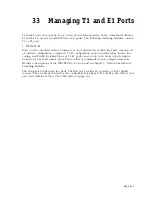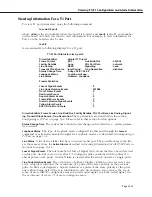
Configuring a T1 Port
Page 33-6
5) Facility Datalink
Facility Datalink (
FDL
) gathers performance statistics every second and stores them in the 24-
hour local statistical database. It also sends local performance statistics to the remote T1 port
depending on the type of
FDL
chosen and the “role” of the
FDL
(specified in the next field).
In order to obtain far-end, or remote, performance statistics (viewed through the
terts
,
tercs
,
and
teris
commands), you must enable an
FDL
protocol.
Note
Facility Datalink requires a T1 port and the frame type
must be Extended SuperFrame.
You have the following choices:
ANSI T1.403
The
FDL
exchange recommended by
ANSI
. The
FDL
method sends Perfor-
mance Report Messages (
PRM
s) to the far-end port every second, processes
received
PRM
s, and stores them in a 24-hour far-end statistical database.
AT&T 54106
The operation of this
FDL
protocol depends on the
Facility DataLink Port
Role
setting (configured in the next field). The
FDL
protocol will either be
active (
network
) or passive (
user
) in its sending of
PRM
s.
T1.403-AT&T
In this combination selection, the port supports both the
ANSI
(
ANSI T1.403
)
and
AT&T
Extended Superframe (
AT&T 54106
) protocols at the same time.
The port processes
ANSI
messages as described for the
ANSI T1.403
option
and responds to
AT&T
request messages.
none
The port does not use Facility Datalink.
6) Facility Datalink Port Role
Indicates the role of this port in relation to the remote port. This setting only affects configu-
rations where the Facility Datalink field is set to
AT&T 54016
. When set to
network
, far-end
historical statistics are updated by periodically sending 24-hour and 1-hour performance statis-
tics requests to the far-end port. When set to
user
, the
FDL
passively waits for messages from
the far-end port.
7) Transmit Clock Source
The source of the transmit clock. Loop timing means the receive clock (recovered from
receive data) is used as the transmit clock. Local timing indicates the local clock source
(generated from
PLL
s) is used as the transmit clock.
The transmit clock source is related to the clocking mode used in circuit emulation services.
In
synchronous
clocking mode, both sides of the T1 connection will use a local clock source.
However, in
SRTS
and
adaptive
clocking, the T1 port receives the clock on one end (loop
timing) and regenerates the clock locally (local timing) on the other end. In such a case, the
T1 port receiving the clock from the network should be configured as
loop timing
and the
other end of the link should be configured as
local timing
.
Summary of Contents for Omni Switch/Router
Page 1: ...Part No 060166 10 Rev C March 2005 Omni Switch Router User Manual Release 4 5 www alcatel com ...
Page 4: ...page iv ...
Page 110: ...WAN Modules Page 3 40 ...
Page 156: ...UI Table Filtering Using Search and Filter Commands Page 4 46 ...
Page 164: ...Using ZMODEM Page 5 8 ...
Page 186: ...Displaying and Setting the Swap State Page 6 22 ...
Page 202: ...Creating a New File System Page 7 16 ...
Page 270: ...Displaying Secure Access Entries in the MPM Log Page 10 14 ...
Page 430: ...OmniChannel Page 15 16 ...
Page 496: ...Configuring Source Route to Transparent Bridging Page 17 48 ...
Page 542: ...Dissimilar LAN Switching Capabilities Page 18 46 ...
Page 646: ...Application Example DHCP Policies Page 20 30 ...
Page 660: ...GMAP Page 21 14 ...
Page 710: ...Viewing the Virtual Interface of Multicast VLANs Page 23 16 ...
Page 722: ...Application Example 5 Page 24 12 ...
Page 788: ...Viewing UDP Relay Statistics Page 26 24 ...
Page 872: ...The WAN Port Software Menu Page 28 46 ...
Page 960: ...Deleting a PPP Entity Page 30 22 ...
Page 978: ...Displaying Link Status Page 31 18 ...
Page 988: ...Displaying ISDN Configuration Entry Status Page 32 10 ...
Page 1024: ...Backup Services Commands Page 34 14 ...
Page 1062: ...Diagnostic Test Cable Schematics Page 36 24 ...
Page 1072: ...Configuring a Switch with an MPX Page A 10 ...
Page 1086: ...Page B 14 ...
Page 1100: ...Page I 14 Index ...
















































